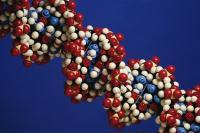Genes in the air, proteins at work
2000/09/01 Roa Zubia, Guillermo - Elhuyar Zientzia Iturria: Elhuyar aldizkaria
Fortunately we have also begun to hear the word proteome. A human's set of genes is called a genome and protein proteome. The mere creation of the word is representative of beginning to understand the importance of proteins. The genome is a mere information, so by manipulating genes in the laboratory it is intended to manipulate the structure of proteins. In short, the biological effects come from the modification of the protein structures.
DNA is a long ribbon molecule. In this way, it has an exact sequence of bases and the information is saved sorted. Changing a base in the sequence would change the information
would be. Consequently, a misreading would lead to error in the ribosomes. In ribosomes, proteins are synthesized making the information read in DNA a sequence of amino acids. Amino acids happen and protein is formed. But if a ribosome error arrives, the right thing is replaced by another amino acid. The protein in formation will therefore not have the proper structure. Such a situation can cause serious problems.
Why the genome?
The genome is transmitted from generation to generation. It is the support of biological heritage. We all have copies of the genomes of mother and father. The combination of both creates one's own. Therefore, to some extent we look physically like parents. But similarity is not limited to physical characteristics. We can also receive genetic diseases, if there are errors in parents' genomes.
Knowing the defects that cause these diseases is one of the great challenges of current medicine. It is not an easy task. Each protein has a very specific role. This means that reading the genome is not enough. To identify a protein you have to capture it "working". Find what you do and how you do it. Moreover, most biological mechanisms involve many proteins simultaneously. Therefore, the origin of a problem often cannot be sought in the simple structure of a single protein.
Therefore, it is surprising to reach the level currently reached by medicine. But the achievement section does not end there. In fact, the genetic origin of certain diseases has been sought without fully understanding the mechanism. For example, we know that Down syndrome occurs in children who have a copy of chromosome 21 in excess. Another thing is to find the solution to the disease.
Genome's research, in addition to a good future, has launched new ethical debates. For example, the patent and cloning of genes have raised fears invented by sci-fi stories of the mid-century. Despite the need to narrow down, any suggestion implied their concern. Cloning, for example, is especially terrifying, but it could open the door to transplant organs grown in the laboratory. Where will the limit be? And where do we put it?
Genetic reading
After numerous pre-projects, Human Genome Project (HGP) was launched. This is an international collaboration sponsored by public bodies for the complete reading of the human genome. Over time they used better technologies and announced their completion by 2003. Scientist Craig Venter, who worked at HGP, created the private company Celera Genomics with the same goal. The company's methodology is faster than the PDR. However, as demonstrated in the case of the fly genome Drosophila melanogaster, with this methodology it is very difficult to read each and every one of the data.
There was competition: who finished the work before. The world's most powerful governments showed their concern about this issue. The authorities requested the publicity of the data to control the genomic conflict. Following other movements, a public and private project was announced in June. HGP and Celera have combined methodologies and efforts.
Therefore, this decision has a lot to do with political decisions, since the debate on the availability of genome data is very intense. Read genome now wants to sell as a major science milestone. It is a political and strategic movement. It has not meant a new real scientific concept. With all this data the door of many years of work opens, but it is clear that, for example, cancer or diabetes will not be cured tomorrow.

Gai honi buruzko eduki gehiago
Elhuyarrek garatutako teknologia




